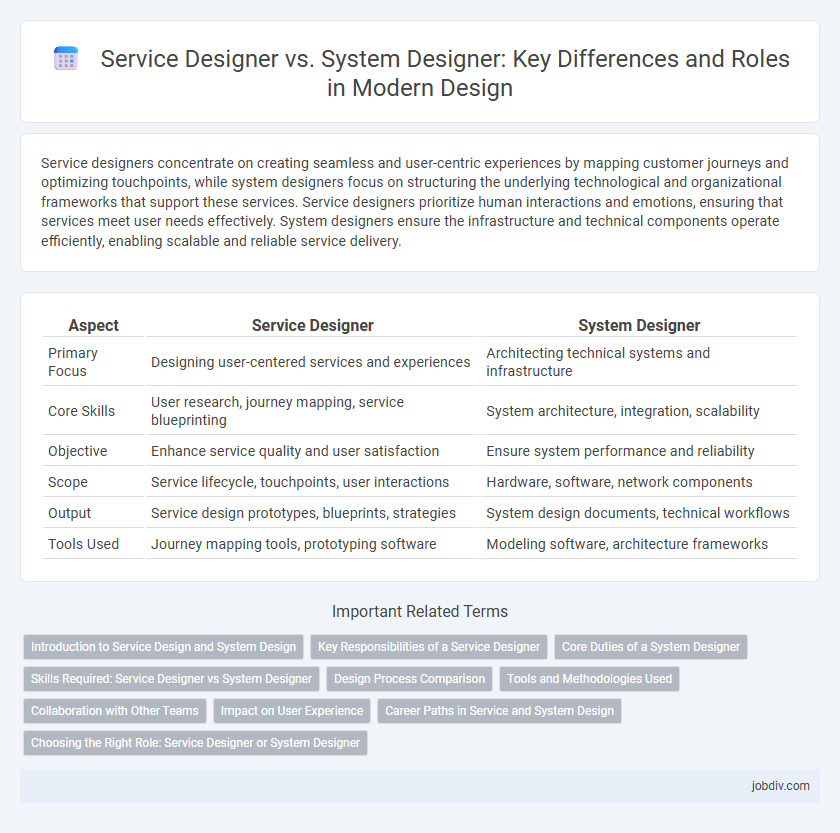Service designers concentrate on creating seamless and user-centric experiences by mapping customer journeys and optimizing touchpoints, while system designers focus on structuring the underlying technological and organizational frameworks that support these services. Service designers prioritize human interactions and emotions, ensuring that services meet user needs effectively. System designers ensure the infrastructure and technical components operate efficiently, enabling scalable and reliable service delivery.
Table of Comparison
| Aspect | Service Designer | System Designer |
|---|---|---|
| Primary Focus | Designing user-centered services and experiences | Architecting technical systems and infrastructure |
| Core Skills | User research, journey mapping, service blueprinting | System architecture, integration, scalability |
| Objective | Enhance service quality and user satisfaction | Ensure system performance and reliability |
| Scope | Service lifecycle, touchpoints, user interactions | Hardware, software, network components |
| Output | Service design prototypes, blueprints, strategies | System design documents, technical workflows |
| Tools Used | Journey mapping tools, prototyping software | Modeling software, architecture frameworks |
Introduction to Service Design and System Design
Service design focuses on creating seamless user experiences by aligning people, processes, and technology within a service ecosystem, emphasizing customer journey mapping and touchpoint optimization. System design centers on structuring and organizing interrelated components in software or hardware to ensure scalability, reliability, and functionality. Understanding both disciplines is crucial for developing integrated solutions that balance user needs with technical infrastructure.
Key Responsibilities of a Service Designer
Service Designers focus on orchestrating customer experiences by mapping user journeys, identifying pain points, and co-creating service touchpoints across multiple channels to ensure seamless interactions. They conduct user research, prototype service solutions, and collaborate with stakeholders to align services with user needs and business goals. The role emphasizes holistic service delivery, integrating people, processes, and technology to enhance customer satisfaction and operational efficiency.
Core Duties of a System Designer
A System Designer primarily focuses on creating and optimizing complex architectures that integrate various components, ensuring seamless functionality and scalability. Their core duties include analyzing system requirements, developing detailed design specifications, and collaborating with engineers to implement efficient solutions. They prioritize system performance, reliability, and maintainability to support robust product development and operational success.
Skills Required: Service Designer vs System Designer
Service Designers require strong skills in user research, journey mapping, and stakeholder collaboration to create seamless customer experiences. System Designers must excel in systems thinking, technical architecture, and integration management to develop efficient and scalable solutions. Both roles demand problem-solving abilities, but Service Designers focus on human-centered design, while System Designers emphasize technical system optimization.
Design Process Comparison
Service designers focus on creating seamless user experiences by mapping customer journeys and aligning touchpoints with business goals, emphasizing human-centered research and iterative prototyping. System designers concentrate on structuring complex technical architectures, ensuring interoperability and scalability through modular design and integration strategies. Both roles require collaborative workflows but differ in scope: service design centers on user interaction and satisfaction, while system design prioritizes backend functionality and system coherence.
Tools and Methodologies Used
Service designers utilize tools such as customer journey maps, service blueprints, and user personas to create seamless customer experiences across touchpoints. System designers employ methodologies like system modeling, UML diagrams, and architectural frameworks to develop and optimize complex technical infrastructures. Both roles prioritize iterative processes and stakeholder collaboration but apply distinct tools tailored to their focus areas in design.
Collaboration with Other Teams
Service Designers collaborate closely with marketing, UX, and customer support teams to create seamless user journeys and ensure the service aligns with customer needs. System Designers work alongside software engineers, IT, and infrastructure teams to develop scalable and efficient technical architectures. Both roles require strong communication skills to bridge user-centric service goals with robust system functionality, enhancing cross-team synergy.
Impact on User Experience
Service Designers enhance user experience by mapping customer journeys and identifying pain points to create seamless, emotionally engaging interactions. System Designers focus on the technical infrastructure, ensuring reliable and efficient system performance that supports user needs behind the scenes. Together, their combined impact results in both intuitive interfaces and robust backend systems, driving overall satisfaction and usability.
Career Paths in Service and System Design
Service designers excel in creating user-centric experiences by mapping customer journeys and optimizing touchpoints, often advancing into roles like Service Design Lead or Customer Experience Strategist. System designers focus on the structural architecture of interconnected components, progressing toward positions such as Systems Architect or Systems Engineering Manager. Both career paths demand strong problem-solving skills but diverge in scope: service design centers on human interaction and value delivery, while system design emphasizes technical integration and operational efficiency.
Choosing the Right Role: Service Designer or System Designer
Choosing between a Service Designer and a System Designer hinges on project goals and scope; Service Designers prioritize user experience and journey mapping to optimize service delivery, while System Designers focus on architecture and integration of technical components within complex environments. Evaluating the desired outcome--whether enhancing touchpoints and interactions or developing scalable, interoperable systems--guides the selection of the appropriate design expertise. Understanding the nuanced distinctions in roles ensures alignment with organizational needs and drives successful solution implementation.
Service Designer vs System Designer Infographic

 jobdiv.com
jobdiv.com